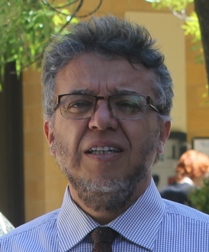DICTA 2021 - Keynote Speakers

|
Keynote Speech 1:
Speaker: Jeremy Howard, fast.ai Title: What we've learned about creating accurate image models quickly and easily. Abstract: We've spent the last few years trying to reduce the barriers to creating image models. That meant figuring out how to train accurate models that needed less data, less compute, less development time, and less complexity. In this talk I'll describe what we've learned during this time, and describe how we've made those learnings easily accessible in an open source software library (fastai). Speaker Biography:
Jeremy Howard is a data scientist, researcher, developer, educator, and entrepreneur.
Jeremy is a founding researcher at fast.ai,
a research institute dedicated to making deep learning more accessible. He is also a
Distinguished Research Scientist at the University
of San Francisco, the chair of WAMRI, and is Chief
Scientist at platform.ai.
|

|
Keynote Speech 3:
Speaker: Professor Mohammed Bennamoun, The University of Western Australia Title: Computer and Robot Vision Abstract:
Robotics has made significant progress in cases of structured and constrained environments, e.g. manufacturing. However, it is still
in its infancy when it comes to applications in unstructured and unconstrained situations e.g. social environments. In some aspects
such as speed, strength and accuracy, robots have superior capacities compared to humans but that is not the case for person/object
recognition, language, manual dexterity, and social interaction and understanding capabilities.
Mohammed Bennamoun is Winthrop Professor in the Department of Computer Science and Software Engineering at the University of Western Australia (UWA) and is a researcher in computer vision, machine/deep learning, robotics, and signal/speech processing. He has published 4 books (available on Amazon), 1 edited book, 1 Encyclopedia article, 14 book chapters, 150+ journal papers, 260+ conference publications, 16 invited and keynote publications. His h-index is 60+ and his number of citations is 16,000+ (Google Scholar). He was awarded 70+ competitive research grants, from the Australian Research Council, and numerous other Government, UWA and industry Research Grants. He successfully supervised +26 PhD students to completion. He won the Best Supervisor of the Year Award at Queensland University of Technology (1998), and received award for research supervision at UWA (2008 and 2016) and Vice-Chancellor Award for mentorship (2016). He delivered conference tutorials at major conferences, including: IEEE CVPR 2016, Interspeech 2014, IEEE ICASSP, and ECCV. He was also invited to give a Tutorial at an International Summer School on Deep Learning (DeepLearn 2017). |

|
Keynote Speech 4:
Speaker: Tao Mei, PhD, IEEE/IAPR Fellow, JD.COM Title: Towards Deep Visual Understanding: from Perception to Cognition Abstract: With the rise and development of deep learning over the past decade, there has been a steady momentum of innovation and breakthroughs that push the limits and improve the state-of-the-arts of visual understanding by visual perception (e.g., object detection and image recognition). Most existing perception techniques heavily rely on large amounts of labeled data and are very vulnerable against adversarial perturbations, which further limits the practical applications of deep visual understanding in the wild. Researchers are now delving into cognition paradigm, which mimics the inference and reasoning abilities of humans. This talk will briefly review recent progresses on deep visual understanding, ranging from perception to cognition, as well as their applications in retail, logistics, and manufacturing scenarios. Speaker Biography:Tao Mei is a Vice President with JD.COM and the Deputy Managing Director of JD AI Research. Prior to joining JD.COM in 2018, he was a Senior Research Manager with Microsoft Research Asia. He has authored or co-authored over 200 publications (with 12 best paper awards) in journals and conferences. He is or has been an Editorial Board Member of leading multimedia journals, and the General/Program Chairs of premier multimedia conferences. He was elected to a Fellow of IEEE (2019), a Fellow of IAPR (2016), and a Distinguished Scientist of ACM (2016), for his contributions to large-scale multimedia analysis and applications. |
